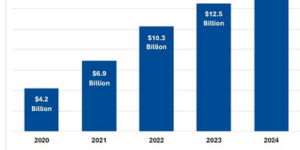Mass transit, the lifeblood of cities worldwide, is under threat from the biggest innovation in automotive technology since Henry Ford’s assembly line first flooded streets with cars.
The self-driving vehicles being pioneered by Tesla Motors Inc., Alphabet Inc.’s Google and others are poised to dramatically lower the cost of taxis, potentially making them cheaper than buses or subways, according to a joint report by Bloomberg New Energy Finance and McKinsey & Co. Having no driver to pay could reduce taxi prices to 67 cents a mile by 2025, less than a quarter of the cost in Manhattan today, the report found.

It’s a change with the potential to reshape commuting patterns, transforming urban life. As prices fall, the challenge for cities is that the cars may become too popular. Instead of complementing public transit, they may lure commuters away from buses and trains, inundating streets with drone cars.
“If we don’t manage this properly, the most dense cities in the world will be pretty unpleasant places to live,” said Colin McKerracher, an analyst with Bloomberg New Energy Finance.
Automakers have significant hurdles to overcome before cars can effectively drive themselves; the technology now is more like an autopilot that must be constantly monitored. While driverless cars have already shown the ability to handle highways, companies are pushing to perfect them for city streets, using GPS to navigate and sophisticated sensors to detect vehicles, pedestrians, bicyclists and pets.
“It’s an astounding development in the transportation world,” said Lucius Riccio, a professor at Columbia University and former New York City transportation commissioner. “This is the first major change in 100 years.”
Taxi, No Driver
The arrival of driverless taxis comes as the industry is upended by ride-sharing services offered by Uber Technologies Inc., Lyft Inc. and others. The prospect of computers at the wheel will dwarf those controversies, imperiling an entire profession immortalized by Robert De Niro in the film Taxi Driver. More than 150,000 people earn their living driving taxis and limousines in New York City, accounting for 4 percent of employment.
“The possibility of self-driving cars in New York is not around the corner, but it is in the future,” said New York City Taxi & Limousine Commission Chairman Meera Joshi.
Elon Musk has pledged to have a Tesla drive itself to New York City from Los Angeles next year. Uber is piloting autonomous vehicles in Pittsburgh. General Motors Co. in March acquired Cruise Automation Inc., which is testing self-driving vehicles in San Francisco. And by 2021, Ford Motor Co. expects to offer a fully autonomous car — devoid of steering wheels and brake pedals — for ride-hailing services.
Once companies work out the kinks, they say driverless technology may make traffic accidents nearly nonexistent. Computers don’t fall asleep at the wheel, get drunk or text while driving. Electric automated vehicles could reduce smog and greenhouse gases. Lower-priced taxis, meanwhile could make bus and train stations more accessible for suburban commuters, boosting mass transit ridership.
Cities are grappling with how to respond. Los Angeles is exploring how driverless vehicles might fill mass-transit gaps. And Boston is working with the World Economic Forum to test whether driverless electric vehicles will reduce pollution and improve safety on the city’s twisting streets.
“We know that humans aren’t very good at driving vehicles, and this is maybe a way to start eliminating those roadway fatalities,” said Kris Carter, co-chair of Boston’s Office of New Urban Mechanics.
Not all cities are embracing the technology. On the same September day Uber began testing Ford Fusions in Pittsburgh, two Chicago lawmakers introduced legislation to ban automated vehicles. “We do not want the streets of Chicago to be used as an experiment,” said Alderman Edward Burke, one of the sponsors of the bill that would impose $500 fines for deploying driverless cars on city streets.
Cabbies are unlikely to vanish all at once. The automated taxis Uber is testing in Pittsburgh have drivers in the front seat, ready to grab the wheel if needed, and initially, they’ll stick to certain neighborhoods. As the technology advances, companies say the cars will start to roam throughout cities, just as mobile phone services gradually blanketed regions years ago.
“Urban driving is the most difficult piece of this,” said Carol Reiley, president and co-founder of Drive.ai, a Mountain View, California, company that develops software for self-driving vehicles. “But that is where we are heading.”
The shift could dramatically recreate streetscapes. Entire lanes may be dedicated to driverless cars. Traffic signals, highway signs and parking lots may become obsolete. Even curbs, designed in part prevent vehicles from careening onto sidewalks, may go the way of the horse-drawn buggy.
“At the same time, we need to remember that cities are for people,” said Seleta Reynolds, general manager of the Los Angeles Department of Transportation. “We can’t let the arrival of driverless cars change that.”





















 Performance Review: Why Insurers Struggle to Underwrite, Price and Reserve for Commercial Auto Risks
Performance Review: Why Insurers Struggle to Underwrite, Price and Reserve for Commercial Auto Risks  Beyond Automation: How GenAI Informs Next Best Action in P/C Insurance Claims and Underwriting
Beyond Automation: How GenAI Informs Next Best Action in P/C Insurance Claims and Underwriting  Severe Midwest Storms Result in Baseball Size Hail
Severe Midwest Storms Result in Baseball Size Hail  The Growth of a New Wave of Distribution Startups in Commercial Auto Insurance
The Growth of a New Wave of Distribution Startups in Commercial Auto Insurance 




